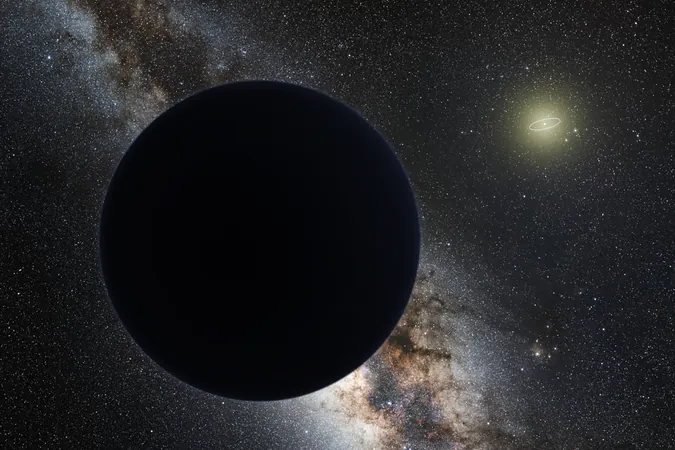
The Enigma of Planet X: Are We Close to a New Discovery?
2025-01-11
Author: Jia
The Search for Planet X: What Lies Beyond Neptune?
For almost ten years, astronomers have been embroiled in speculation over the existence of a hypothetical giant planet—often dubbed "Planet X" or "Planet Nine"—that may be lurking on the fringes of our solar system. This elusive planet could potentially explain the odd behavior observed in trans-Neptunian objects (TNOs), located far beyond Neptune. For these TNOs, there are signs that suggest they are being influenced by a substantial, unseen gravitational force.
Though many hypotheses have been proposed, including the possibility of an expansive disk of smaller objects or even a primordial black hole, the search for Planet X has intensified recently. Researchers have broadened their study from 11 TNOs to a staggering 51, generating new forecasts that suggest this hypothetical planet might possess a mass roughly 4.4 times that of Earth and orbit around 300 times further from the Sun than we reside.
Most significantly, the projected orbit positions Planet X squarely in the field of view of the Vera C. Rubin Observatory's upcoming Legacy Survey of Space and Time (LSST), set to launch in late 2025 in Chile. This facility boasts a robust capability to explore the unexplored realms of our solar system. Researchers are optimistic that if Planet X exists, LSST will pinpoint it early on in its observational campaign.
“Nearly all potential parameters for this unseen planet align perfectly with LSST’s detection limits,” said Amir Siraj and his team from Princeton University, emphasizing the critical role LSST will play in resolving the mystery of the clustered TNOs.
With the new findings, scientists also suggest that the orbit of Planet X may align with the solar system's plane. This alignment raises intriguing questions about its origins; a planet that follows this trajectory is more likely to be a native member of our solar system rather than something that wandered in from another star system.
In these turbulent times, marked by climate crises and political unrest, the notion of discovering a new planet feels like a much-deserved reward. Let's hope that by 2026, we will either welcome Planet X into our cosmic family or finally conclude it was just an astronomical myth.
The Dramatic History of Pluto and Charon
Speaking of celestial oddities, let's delve into the tale of Pluto, the dwarf planet that sparked controversy when it was demoted in 2006. Pluto, along with its moon Charon, might not be classified as traditional planets, but they represent the most significant binary system among TNOs.
Recent research suggests that Pluto and Charon came into existence following a colossal collision between two icy bodies billions of years ago. Scientists have developed a new model to explain this formation, coining it the "kiss-and-capture" theory. In this scenario, the two colliding bodies merged for a short time before separating, leaving behind the Pluto-Charon duo we observe today. This model helps explain many geological characteristics we see on these distant bodies today.
Saber-Tooth Cats: A Glimpse into the Past
Switching gears to the fascinating world of prehistoric creatures, recent studies have confirmed the functional superiority of saber teeth in predatory mammals. Saber-toothed animals, such as the famous Smilodon, utilized these distinctive teeth for effective killing bites—a method that has shown to evolve independently at least five times across different species. The last saber-tooth cat went extinct a mere 10,000 years ago, sparking curiosity about the encounters between these formidable beasts and early humans.
Punk and Emo: The Mollusks of the Silurian Era
In a delightful twist, paleontologists have identified two new mollusk species from 430 million-year-old fossils that evoke the spirit of punk rock. Dubbed "Punk ferox" and "Emo vorticaudum," these ancient mollusks reflect the vibrant cultural movements that came long after their existence. "Punk" represents the rebellious nature of its appearance, while "Emo" highlights characteristics reminiscent of the emo subculture's iconic fringes.
As we stand on the brink of astronomical discoveries and unravel the stories of our past, please stay tuned for what's next in our exploration of the universe!

 Brasil (PT)
Brasil (PT)
 Canada (EN)
Canada (EN)
 Chile (ES)
Chile (ES)
 Česko (CS)
Česko (CS)
 대한민국 (KO)
대한민국 (KO)
 España (ES)
España (ES)
 France (FR)
France (FR)
 Hong Kong (EN)
Hong Kong (EN)
 Italia (IT)
Italia (IT)
 日本 (JA)
日本 (JA)
 Magyarország (HU)
Magyarország (HU)
 Norge (NO)
Norge (NO)
 Polska (PL)
Polska (PL)
 Schweiz (DE)
Schweiz (DE)
 Singapore (EN)
Singapore (EN)
 Sverige (SV)
Sverige (SV)
 Suomi (FI)
Suomi (FI)
 Türkiye (TR)
Türkiye (TR)
 الإمارات العربية المتحدة (AR)
الإمارات العربية المتحدة (AR)